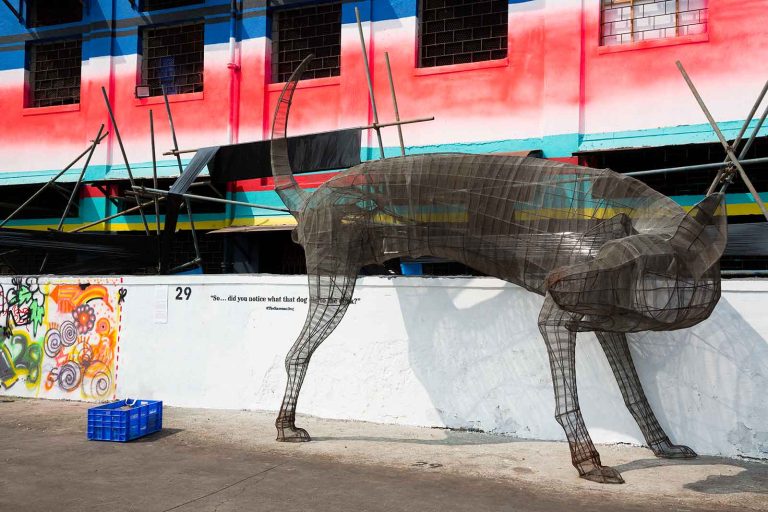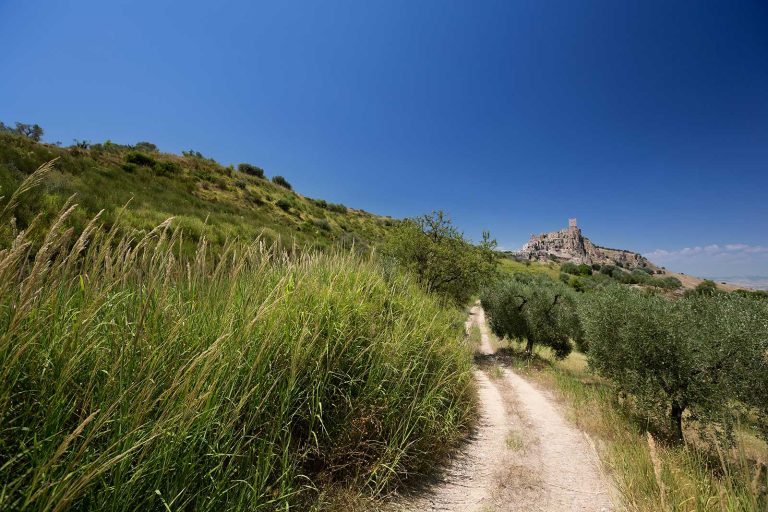Austria is an often-overlooked corner of Europe, with many travelers hitting neighboring Germany instead. Travelers know the country for its sweeping landscapes and classical music, but it has an interesting cuisine as well. In this post, I share our tips on what to eat in Austria, with a focus on traditional Austrian food and cuisine.
*This post contains compensated links. Find more info in my DISCLAIMER. As an Amazon Associate, I earn from qualifying purchases.
Traditional Austrian Food Guide
Our first trip to Austria was a little whirlwind. In and out between a longer stay in Budapest and on our way to Slovakia. During our second trip, though, we had a lot more time to experience Austria, from dining in Vienna to discovering food and drink experiences in smaller cities and villages.
How We Traveled Through Austria
This trip through Austria was a little unique for us. We explored Austrian cities and villages on board a Danube river cruise with Avalon Waterways. (Read our full review of our Avalon Waterways Danube River Cruise.)
Before this experience, I was probably like a lot of travelers who think that cruising means eating mediocre food on a cruise ship while spending the days on typical walking tours of each destination.
Check out our guide to Austrian Drinks – What To Drink When Traveling In Austria
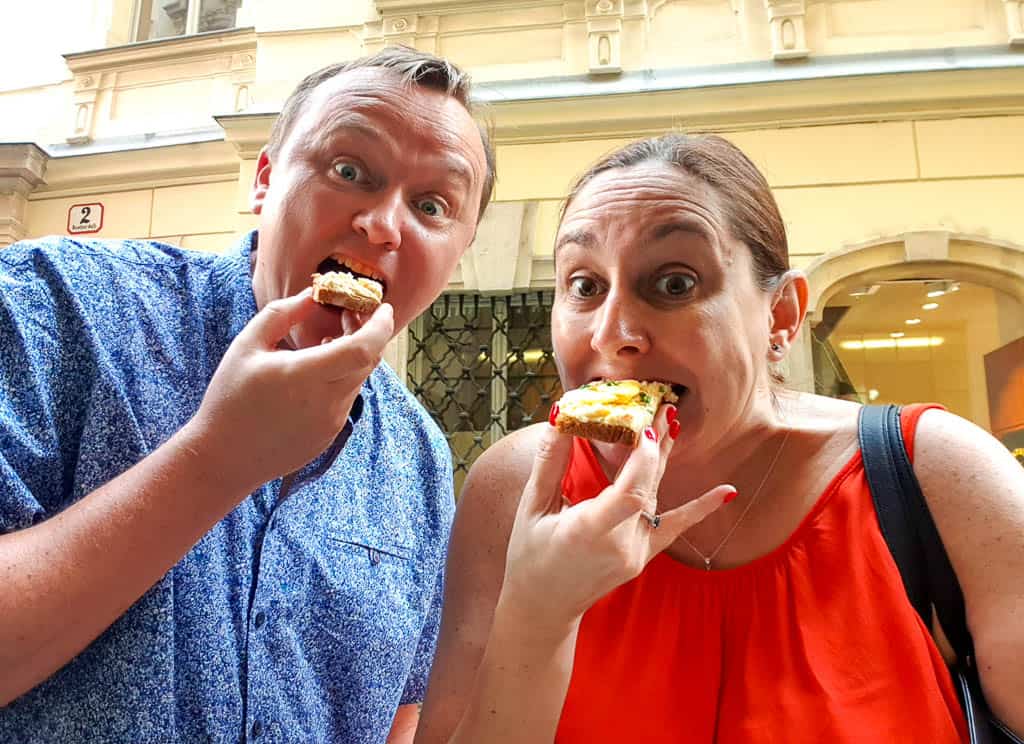
Active Cruising
This could not be further from the truth. Not only did Avalon do a fabulous job of offering traditional Austrian cuisine at each meal, but their Active and Discovery Cruise meant loads of super-unique Austrian food and drink experiences.
They helped us learn what to eat in Austria. We also didn’t feel overly scheduled during our cruise. We tried some of the dishes mentioned in this Austrian food guide onboard. In Vienna and Linz, though, we explored on our own a bit as well.
Avalon’s way of cruising means you can be as scheduled or as independent as you want. That’s how we spent much of our time in Vienna. We researched what to eat in Vienna and then tracked down those dishes in the cities and villages we visited.
What Is Austrian Food
It’s sometimes difficult to define traditional Austrian food. There are so many influences from Germany and other nearby countries. This is particularly true because at various points in their history these countries were joined, separated, occupied, or liberated.
As a result, Austrian food culture is intertwined with that of Germany, Hungary, and other nearby countries. There is also a distinct difference in some of the most typical dishes based on region. Viennese food is going to be different from that you’d find in say, Salzburg.
Our tour through Austria focused on the Danube. When it comes to what food to try in Austria, many of the dishes will depend on the city or town you are visiting.
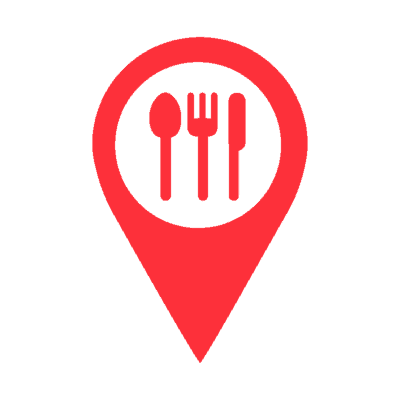
Traditional Austrian Food Facts – Pro Tip
One thing to know about eating in Austria is that the portions can be huge. Sometimes they measure wiener schnitzel by how many hands it is, meaning “this schnitzel is three hands big.” Be prepared.
Share dishes where possible. There are also plenty of opportunities for snacking, which gives you an opportunity to try typical Austrian food without filling up, or breaking the bank.
#gap-253165279 { padding-top: 30px;
}
What To Eat In Austria
Austrian cuisine shares a lot of similarities to the cuisine of its neighbors, including German food and Hungarian dishes. This is not surprising. I tried to include in this list the most Austrian of dishes, but recognize some of them might originate with their neighbors.
These are, though, the dishes you are most likely to find on an Austrian restaurant menu. There are also some regional specialties as well, although you are likely to see most of these dishes on a menu in Vienna, which is an international city.
Wienerschnitzel – National Dish of Austria

This is probably the most famous Austrian dish. Although called Vienna Schnitzel in Vienna, it is known elsewhere in Austria and in many countries of Europe as Wienerschnitzel or wiener schnitzel as two words. Regardless of what you call it, wiener schnitzel is the quintessential Viennese food.
The Wien portion of the name is actually a reference to Vienna, which means this is a true Austrian dish. And if you are wondering what to eat in Vienna, this is the number one dish to recommend.
What Is Wiener Schnitzel
One of the more straightforward Austrian recipes to make, Wienerschnitzel is a thinly pounded piece of meat, generally veal. It is breaded and deep-fried. It is normally served with a cold potato salad and a wedge of lemon.
Avalon Waterways organized a cooking class for us as one of our excursions. I put Eric to the task of pounding the meat thin but enjoyed learning a new recipe for potato salad. These are pretty easy dishes meaning it’s possible to make Austrian delicacies at home.
Where To Eat Wienerschnitzel In Austria
As to where to eat Wienerschnitzel in Austria? Pretty much everywhere. You will have no problem tracking down this dish. Be prepared, it’s normally a big dish. Perhaps share a portion.
Although normally made with veal, which is traditional and regulated by Austrian law, restaurants do also offer chicken or pork versions as well. Look for Wiener Schnitzel vom Schwein for the pork version.
Where to eat wiener schnitzel in Vienna? Our friend Matt from Landlopers swears by Figlmüller in Vienna.
Austrian Snacks and Appetizers
After covering the Austrian national dish, I want to start with Austrian appetizers and snacks. These are foods that people snack on during the day. Some of them are considered Austrian street food. This is a great way to try a variety of foods without committing to a big dish at a sit-down restaurant.
Belegte Brote – Open-Faced Sandwiches
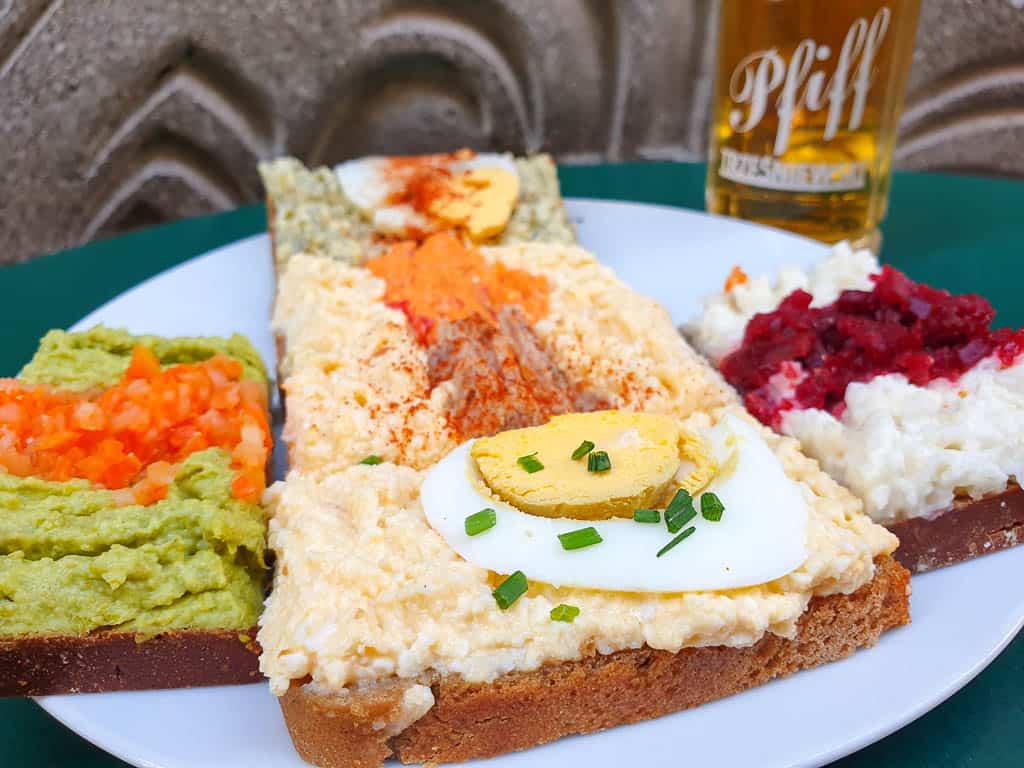
Similar to the open-faced sandwiches we’ve eaten in Prague, these are a must-eat dish in Vienna. They are small pieces of bread topped with all sorts of tastiness.
The most traditional are herring, chicken liver, and egg, but there are so many varieties now. They are normally eaten for a weekday lunch or as a snack. Although this is really a Czech import, the family that founded Trześniewski in Vienna is Austrian. They have about a dozen locations in Vienna.
We tried a variety of belegte brote (brote means bread in German). My favorite included something similar to coleslaw and pickled beets and one topped with paprika sauce.
Eric liked one with hard-boiled egg and relish. I will note, you should definitely like egg salad if you try this dish. Although not every version included egg salad, most did. To me, they were entirely tasty. An order of six open-faced sandwiches cost about €8.
Wiener Würstels – Vienna Sausages

There is no shortage of sausages in this part of the world, which is why Eric loves the food so much. Look for Wiener Würstels at a Würstelstand, meaning it’s an Austrian street food that you can find at sausage stands. These sausage stands are everywhere and are some of the best places to eat in Vienna.
These taste best with a cold Austrian beer and some spicy mustard. This is Austrian street food at its finest. Walk up to a stand, order a beer and a sausage and use one of the ledges or tables to eat street-side.
There are different varieties of Vienna sausages as well, including ones that are spicy (called Bosna) or stuffed with cheese – you know, to make it healthier. Some of the variations are specific to regions within Austria.
You might be asked if you want it semmel or mit brot. Semmel is in a bun and mit brot is with bread. If you order it with bread, they will slice the sausage, making it easier to eat.
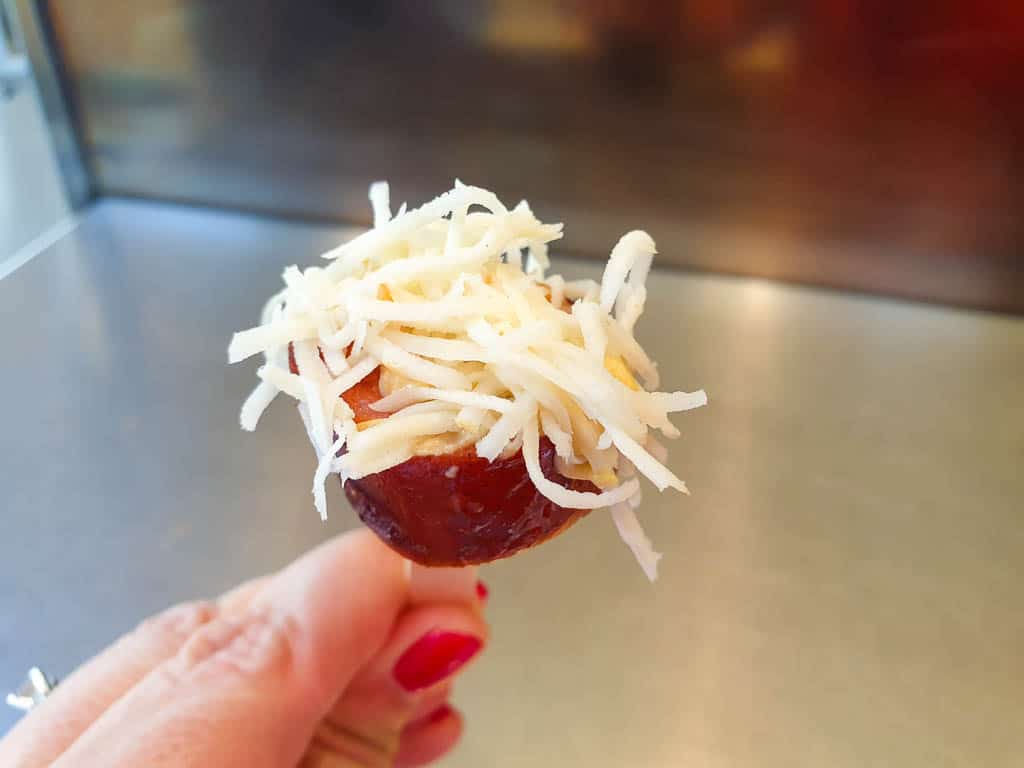
Here are some of the most commonly found sausages at a wurst stand.
Grillwurst or Grillwurst Scharf – grilled sausage or spicy sausage, served with ketchup and mustard and sometimes shredded horseradish
Käsekrainer – grilled sausage stuffed with cheese, served with ketchup and mustard
Bratwurst – original Viennese style white sausage
Currywurst – sliced sausages served with curry sauce and bread or fries (the perfect late-night snack)
Weisswurst – Bavarian White Sausage
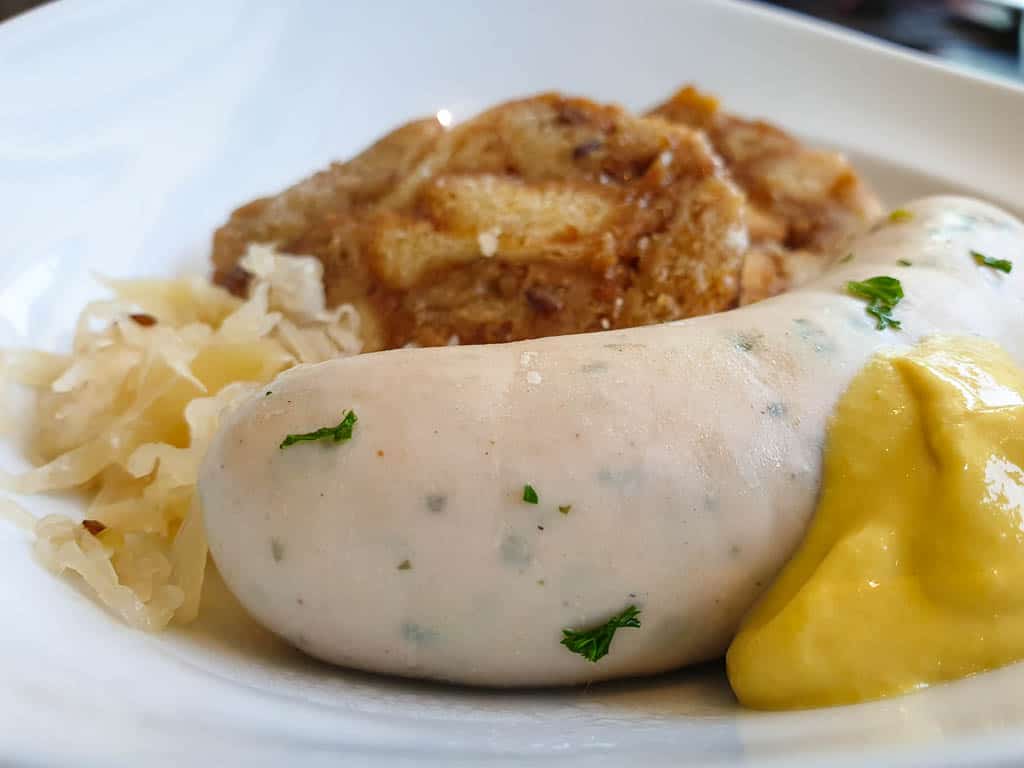
In Upper Austria, they speak the same dialect as the Germans do in Bavaria. We traveled so far up the Danube we were a stone’s throw from Germany. So it is no surprise that there are some Austrian dishes that are Bavarian influenced.
This is true for the weisswurst, a Bavarian white sausage. It’s a veal and pork sausage made with onion and parsley. It’s super soft and even the casing feels almost delicate.
They may look a little grey, but taste much better than they look. Avalon served the Bavarian white sausage along with sliced bread dumplings and sauerkraut. It doesn’t get much better than this for a typical Bavarian lunch.
Leberkäse or Käseleberkäse
Leberkäse is pressed meat and is also served at most wurst stands, but it is in a different category to all of the sausages above. It is made of pork and has the consistency of spam.
It is sliced, placed on a roll, and slathered in mustard or ketchup. Käseleberkäse is also pressed meat, but there is cheese pressed inside the meat, so it oozes out when sliced.
Gulasch – Goulash

One of the most typical dishes found in Austria, Hungary, and other neighboring countries. Goulash is an Austrian beef soup or stew made with meat, potato, and vegetables and flavored with paprika, which is definitely a Hungarian influence.
For something more Austrian, look for Saftgulash, which is more slow-cooked. It includes beef and onions. There’s no better way to eat goulash than with a few dense potato dumplings to soak up all of the juice.
Vienna Sacher Sausage With Goulash Sauce
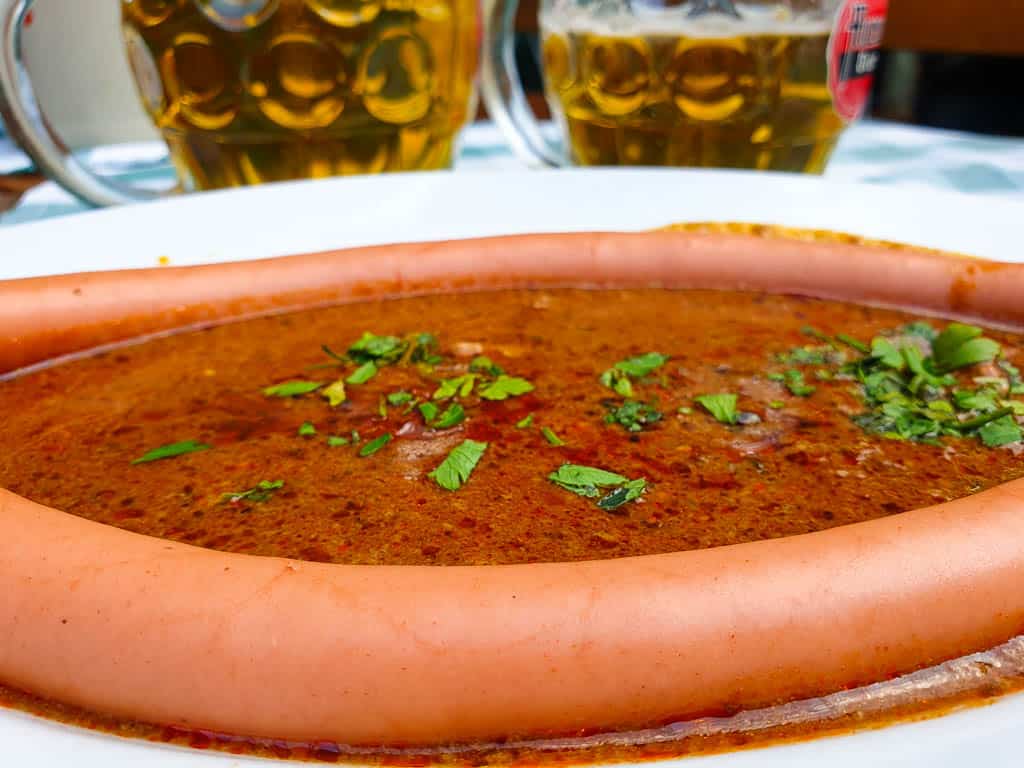
Let’s keep heading down the sausage rabbit hole. While exploring the Naschmarkt in Vienna, we stumbled upon a traditional Austrian restaurant where Eric could not say no to yet another form of sausage.
This type is more similar to an American-style hot dog, long and thin. In this case, they served it with a smoky, beef-flavored goulash sauce, which was perfect for dipping.
Martinigans
Growing up in the US it was always chicken. Since traveling abroad and now living in Europe, we find ourselves eating more duck and in the case of martinigans, goose. Martinigans is a goose that has been stuffed and roasted. The dish is very popular on the Austrian holy day of St. Martin. The goose is stuffed with a combination of chestnuts and dried plum giving it a hint of sweetness.
Tafelspitz
This is a seemingly simple dish, with a hard-to-pronounce name. That is not unusual, though, when talking about Austrian cuisine. Tafelspitz is boiled beef or veal that is cooked in a seasoned broth with vegetables. It translates to the tip of the meat, which is a reference to the cut of meat.
It is often served with apples, horseradish, or sour cream. One of the reasons why it is so popular is that it was rumored to be a favorite of the Austrian Emperor Franz Joseph.
Wiener Backhendl
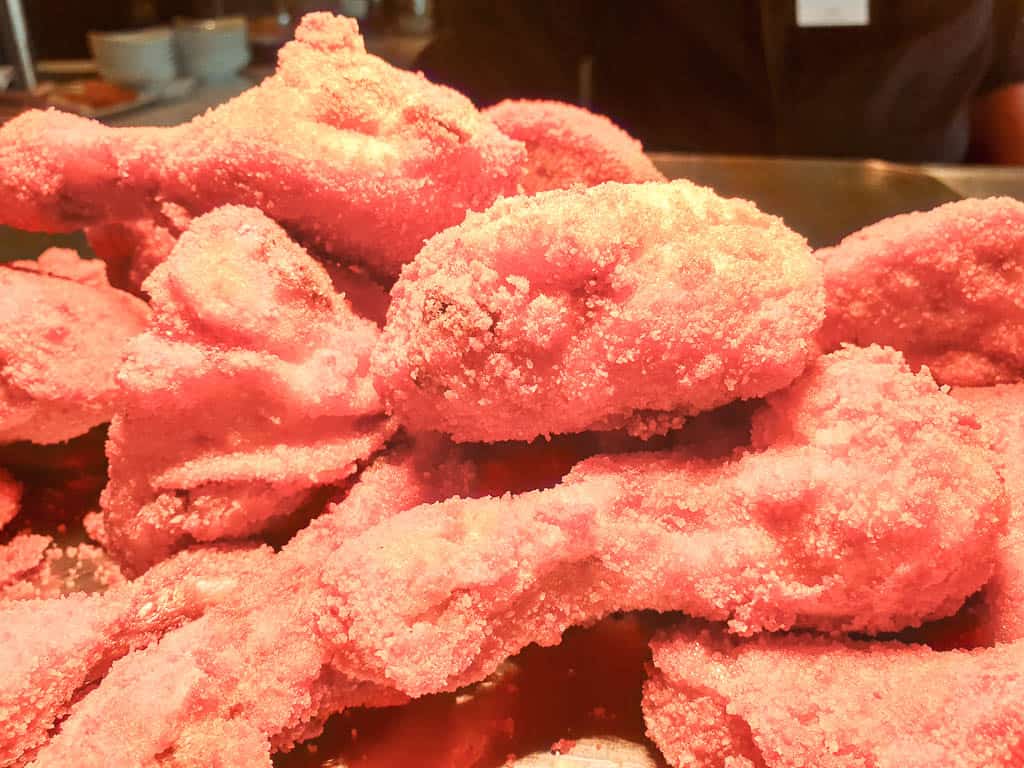
Is it rude to call this Austrian fried chicken? That’s really what it is, breaded chicken legs and thighs, with a crispy breading.
We actually ate this on our Avalon cruise during lunch one day and the breading had a little bit of spice to it. Everyone at the table seemed to grab seconds on this one.
Mondseer
We had to include at least one Austrian cheese in our list. Mondseer or Schachtelkase is a pasteurized cow’s milk cheese from the town with the same name. Mondseer can also be made using goat’s milk. The cheese itself is smooth with a hint of acidity. Buttery and creamy, Mondseer is closest to a Munster or Limburger in terms of flavor. It pairs nicely with either an Austrian red or white wine, depending on the time of the year.

Austrian Food Facts – Pro Tip
Here’s a little Austrian language lesson. In Austria, people speak German. There are two words that might be confusing to travelers to Austria. Wien is the German word for the city of Vienna. The word for wine in German is wein. When you see Wiener before a word, it means that it is a dish that originated in Vienna. That is not to be confused with wein, which is just wine!
#gap-685898418 { padding-top: 30px;
}
Austrian Dishes With Noodles And Dumplings
My fascination with all things noodles and dumplings is not a secret. Some of these are main courses in their own right, but some are served as side dishes or snacks as well.
These might not be the most famous traditional Austrian food dishes, but I was thrilled with all the different varieties of pasty-type dishes in Austria. Here are just some of them to eat while traveling in Austria.
Kaspressknödel – Cheese Dumplings
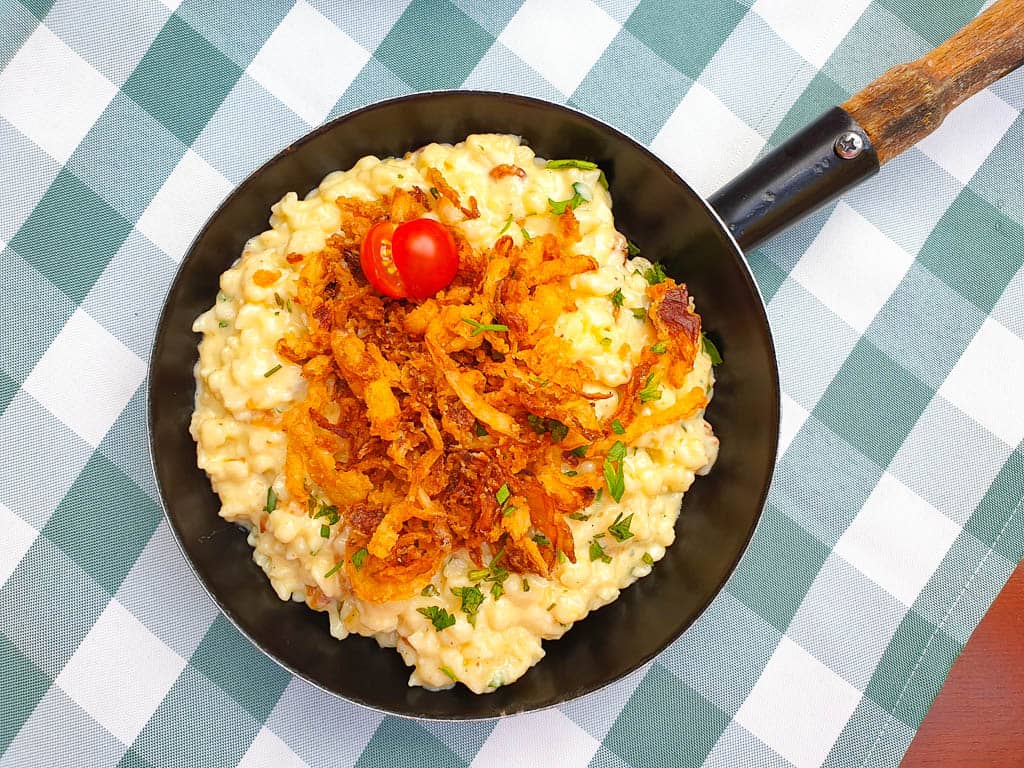
I love all things dumplings, regardless of which continent they come from. Add some cheese into the mix and I am in heaven. Kaspressknödel originates from Tyrol. They can be described as Austrian macaroni and cheese, so how could I say no?
The menu described it as cheese gnocchi. Kaspressknödel is small dumplings and are normally served pan-fried or baked. The version I ate was slathered in a creamy cheese sauce and topped with fried onions. I couldn’t even come close to finishing this dish.
Where to eat Kaspressknödel in Vienna: Zur Eisernen Zeit at the Vienna Naschmarkt
Schlutzkrapferl Tris and Spinatknödel
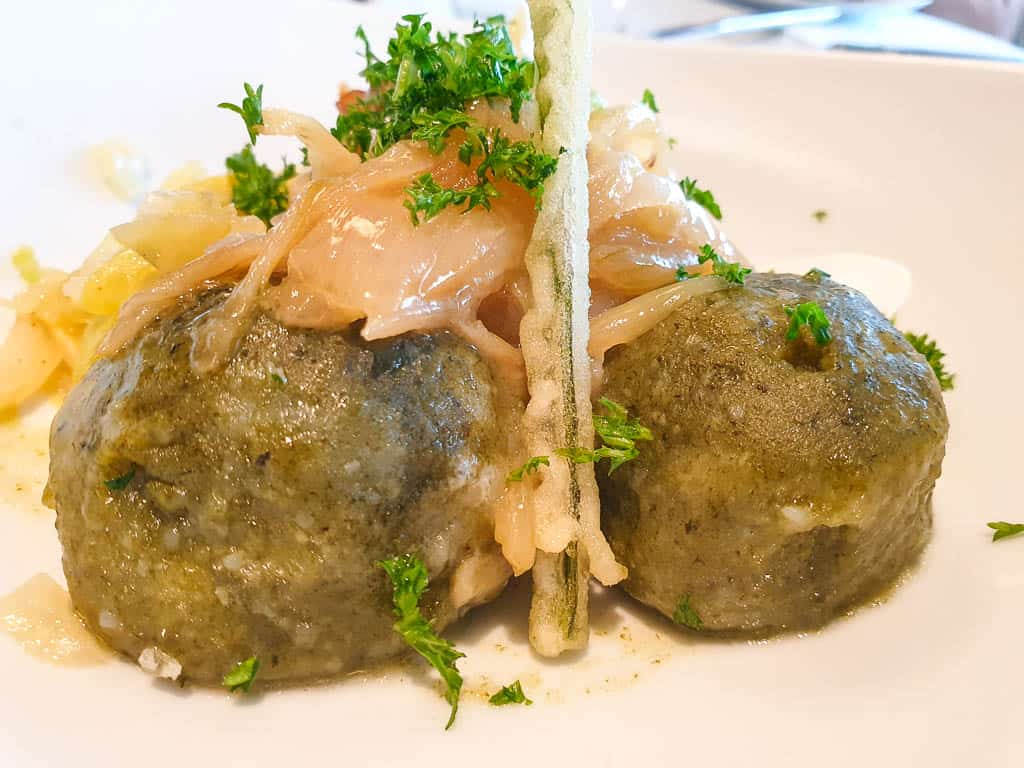
Talk about a dish that is difficult to pronounce, this was one dish I was happy to point to on the menu while smiling instead of butchering the Austrian language.
Schlutzkrapferl Tris is an Austrian-filled pasta that is reminiscent of a ravioli. It can be stuffed with a variety of fillings, often changing with the seasons. Look for Austrian cheese or spinach. The sauce is simply melted butter.
You might also see Spinatknödel on a menu, which is a slightly more dense dumpling made of spinach. The version we ate was served in melted onion butter. These dumplings have a more sticky consistency.
Schupfnudeln

Schupfnudeln is an Austrian potato-based pasta that is normally served with sauerkraut and pork. It almost has the consistency of dense gnocchi, but the version we had was pan-fried giving it a nice texture.

What To Eat In Vienna Pro Tip
If looking for a local market in Vienna, check out the Vienna Naschmarkt, which is located in the city center and main tourist attractions. It’s less than a 10-minute walk from the Opera House. During the day, there are food stalls, including butchers and fishmongers.
At night, there are loads of dining options. Although many of the restaurants are international, there are some more traditional Austrian restaurant options and several places to enjoy Austrian beer or wine.
#gap-1051226126 { padding-top: 30px;
}
Austrian Desserts And Pastries
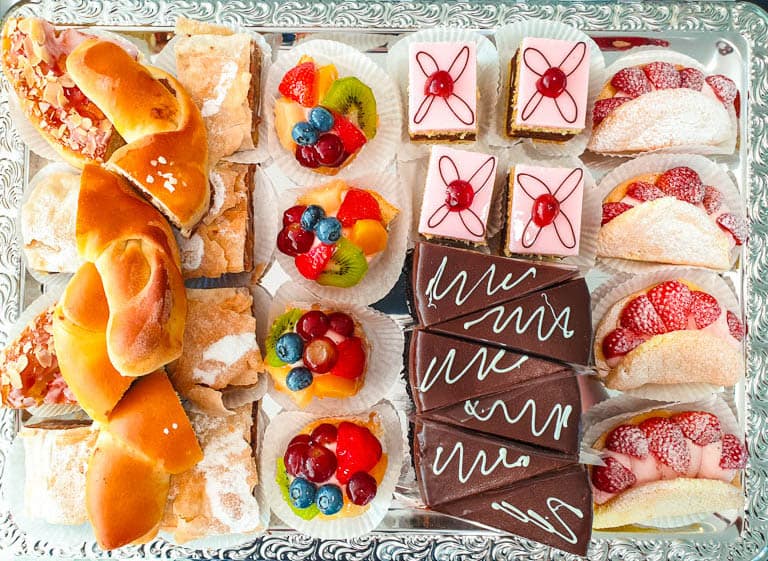
We always say we are not huge dessert people because we always fill up on the savories. We made a few exceptions though for some of these Austrian desserts and pastries because they are so darn good.
It also helped that when we were onboard the Avalon Impression, their pastry chef did a heck of a good job at putting desserts right under our noses!
Sachertorte
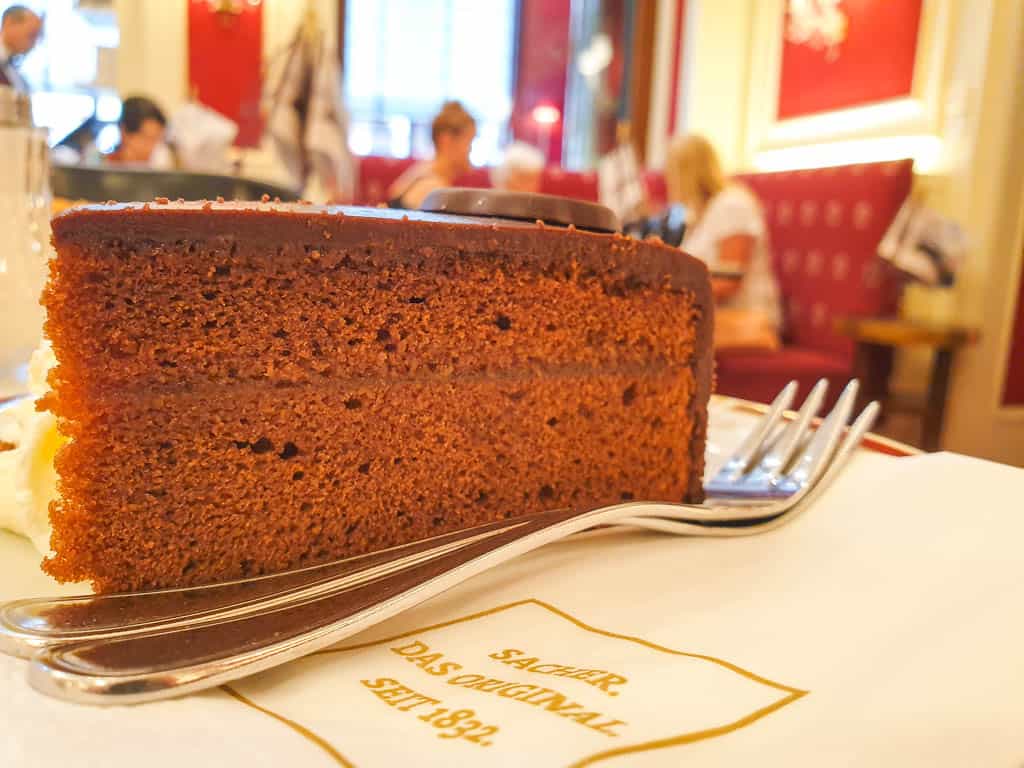
If you ask people what Vienna is known for they would most likely answer schnitzel and Sachertorte. It’s a rich, layered chocolate cake with an apricot jam in the center.
To top it off there’s chocolate icing on the top and is served with thick whipped cream. It was invented in the 1800s and is the most traditionally enjoyed in a beautiful Viennese coffee house. The coffee house is bursting with Austrian pastries and desserts, making it a must-visit for anyone with a sweet tooth.
Where to eat Sachertorte in Austria
We went to the original Cafe Sacher at Hotel Sacher in Vienna. Inside, we sat in an elegantly decorated, historic coffee house (with a lot of other tourists) to try their famous €7.50 Sachertorte.
We are not big dessert people, and when we do eat dessert we prefer something light on the chocolate. I will note that we are not alone in saying the cake portion of the tort is rather dry, so this was not my favorite food to eat in Austria.
I actually enjoyed the version I had onboard Avalon better as it was moister and layered with apricot.
Apfelstrudel – Apple Strudel
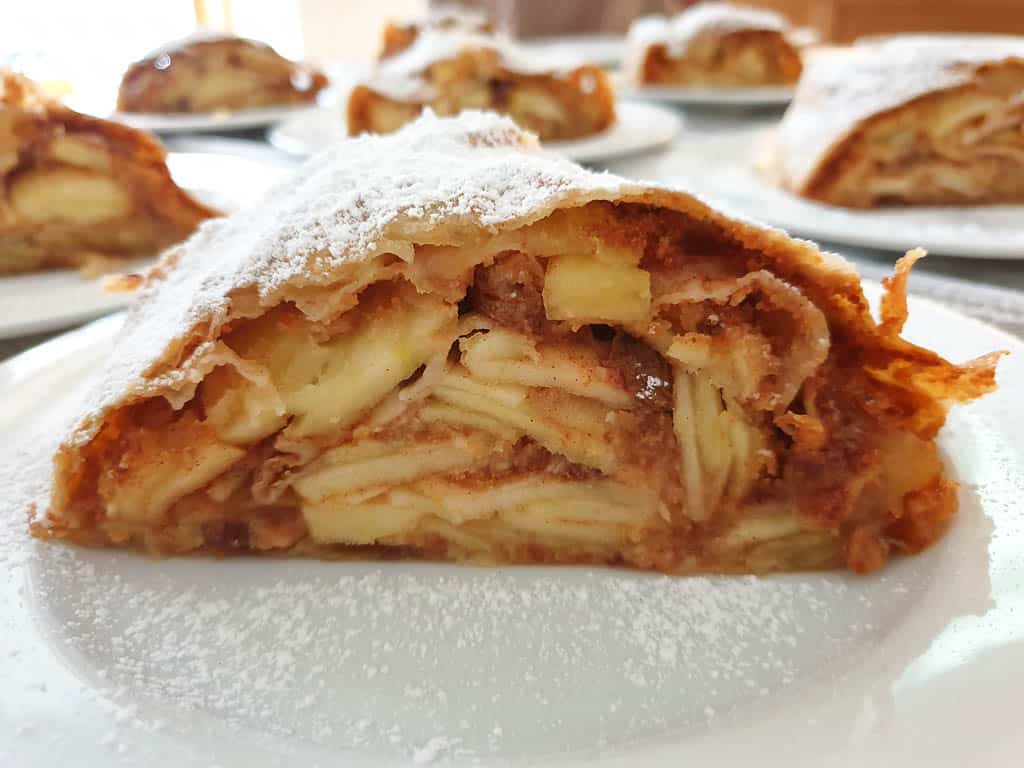
This is one of the most famous desserts to eat in Austria and in surrounding countries as well. The word strudel translates roughly to swirl, so it is a pastry swirl layered with thinly-sliced apples, butter, and cinnamon. Some versions also include rum-soaked raisins for an extra kick. If you ask Eric of all the Austrian dessert dishes available which is his favorite, he’ll tell you apple strudel.
Where To Eat Apple Strudel In Austria
It’s pretty easy to find this pastry as a dessert on most traditional Austrian menus. There are also shops that specialize in strudel. I ate this dish a few times during our cruise from Budapest to Linz, but we also learned to make our own.
One of the best excursions we took during our Avalon Waterways cruise was to a Vienna cooking class. We learned to cook apple strudel from scratch!
I have a lot more respect for the seemingly simple strudel now that I know how to cook it. From rolling out the dough to soaking the raisins in rum and slicing the apples super thin. I look forward to taking what we learned home with us.
Kaiserschmarrn – Austrian Pancakes
I always hesitate to use a word like pancakes to describe dishes because it is a word used to describe so many different foods. In this case, Kaiserschmarrn is cut into small pieces, covered in powdered sugar, and has more of an egg taste than an American pancake.
Instead of syrup, they are normally served with fresh fruit or preserves. This Austrian dessert is actually named after the Austrian Emperor Franz Josef, the Kaiser. Apparently, these little pancakes were his favorite dessert.
Palatschinken – Austrian Crepes
Palatschinken is also a pancake or crepe but is very different from Kaiserschmarrn. These are more traditional crepes, which are also found in Hungary. They are often layered with apricot jam and rolled.
Manner Wien

I’ve seen these snacks at shops throughout Europe but didn’t realize they originate from Vienna. A little silly because the label says Wien, which is the word for Vienna.
Manner Wien is a layered wafer treat, filled with chocolate in between. While visiting the Vienna Schnapps Museum during one of our excursions with Avalon I even saw a liquor flavored like Manner Wien – and the flavor seemed spot on!
Wiener Buchtein
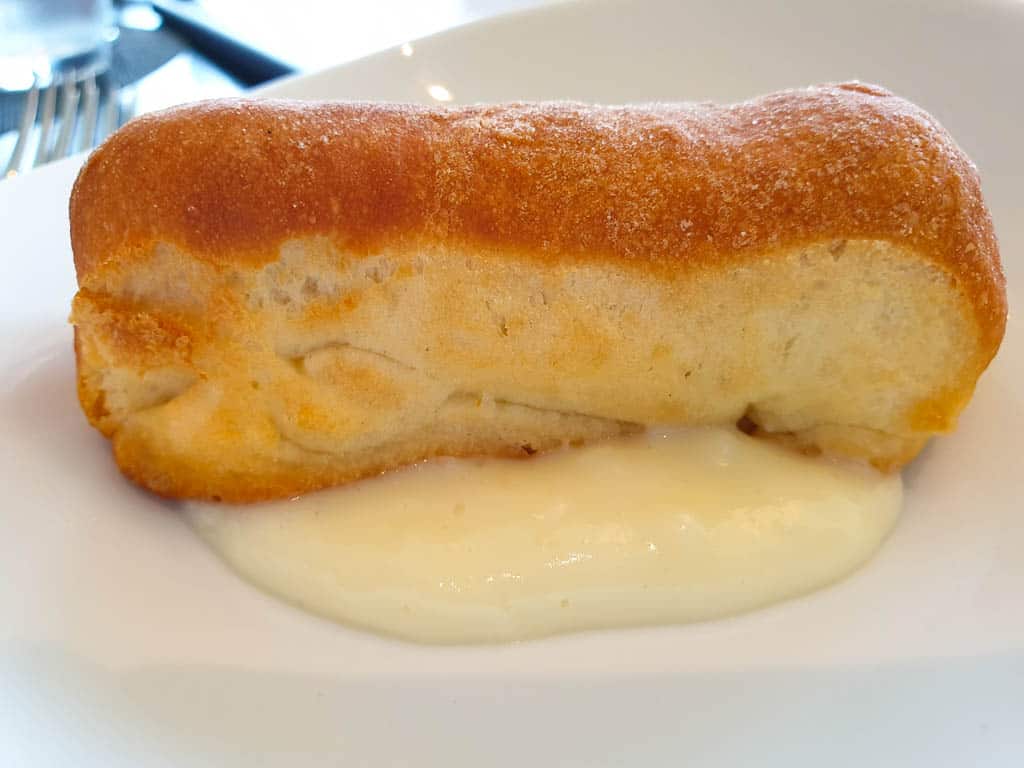
Wiener Buchtein is a Viennese sweet yeast bun, filled with apricot jam or plum jam and served with warm vanilla sauce. They are baked in a large pan so that they sort of stick together and need to be pulled apart.
This is a Bohemian dish, but we tried it onboard our Avalon cruise. I liked it because it was not overly sweet. The perfect treat after a typical Austrian lunch.
FAQs – Traditional Austrian Food Guide – What To Eat In Austria
Vienna is not a budget destination. Expect to pay between €15-20 for a wiener schnitzel but other main courses, particularly goulash and noodle dishes are less, normally between €10-15. A beer at a wurstel stand is only €2.50 but at a restaurant is around €3.50-4. A sausage snack on the street will cost around €4. Prices drop a bit outside of the capital city.
I often think that Austria is overlooked when it comes to food because it is famous for so many other things. This includes being the birthplace of both Mozart and the painter Gustav Klimt. People love to see performances at Vienna’s famed Opera House but you can see classical music all through the city.
In May each year, Vienna hosts the Genussfestival, Austria’s largest food festival. It’s held at Vienna’s City Park and several hundred vendors highlight various Austrian specialties.
Austria is world-renowned for its sweet desserts. So it should come as no surprise that many Austrians prefer to start the day with a sweet breakfast. Like many Europeans, breakfast is generally a light meal.
A typical Austrian breakfast includes bread or croissants accompanied by butter and fruit jam. Fresh juice and of course coffee, round off a typical breakfast. It is not uncommon to see an Austrian breakfast that includes ham, cheese, and other cured meats.
* iambassador managed this trip in partnership with Avalon Waterways. As always, Food And Drink Destinations maintains full editorial control of the content published on this site. Learn more about Avalon Waterways Active and Discovery Cruises where they help you explore more while cruising.

